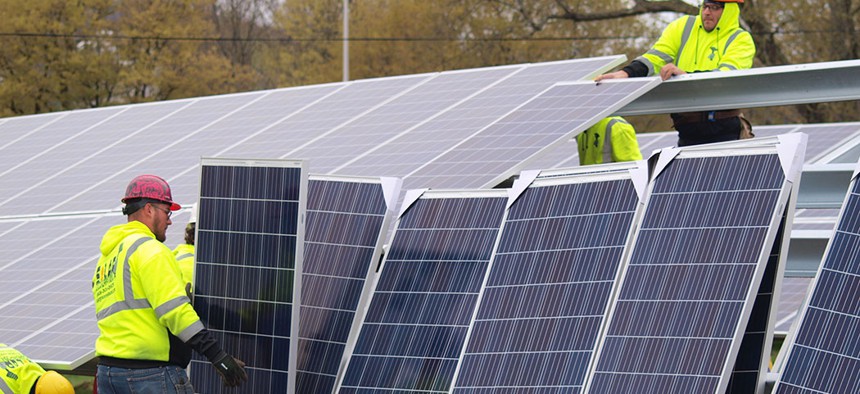It’s climate week in New York City, so what better time for the state to release a report on clean energy job trends? The New York state Energy Research and Development Authority released its 2019 Clean Energy Industry Report with the latest numbers on job growth in various sectors of the industry. The state has lofty environmental goals that were codified by the Climate Leadership and Community Protection Act earlier this year – including hitting 100% clean energy from the electric sector by 2040 and to reduce carbon emissions by 85% by 2050. To meet these goals, ramping up clean energy jobs – which itself is included as a goal in the new state law – will be essential.
Overall, New York seems to be trending in its intended direction, although a closer look at the numbers certainly shows room for improvement. The state highlighted the positive growth in the energy industry in 2018 – an 8.9% increase since 2016 and a 4.8% improvement over 2017. According to the report, the two-year growth is more than double the employment growth of the state’s overall economy. In total, that’s nearly 159,000 jobs statewide, with even more growth projected for 2019. Clean energy employment growth in New York in 2018 also outpaced the national average for clean energy employment, which stood at 2.7%.
The report includes a range of different breakdowns of these broad statistics that, while still illustrating growth, present, at times, a more modest picture when looking at clean energy as a whole. Within the industry, energy efficiency jobs account for about 78% of the total number of clean energy jobs. Renewable electric power generation, alternative transportation, renewable fuels, grid modernization and power storage are the other technologies that account for the other 12%. While energy efficiency is an important of hitting statewide goals, expansion in the other four sectors will be crucial and there is still plenty of room for growth there.
Among the five technologies included in the report, grid modernization and energy storage had the fastest rate of growth, increasing over 52% since 2016 and 35% in 2018 alone. This is well above the predicted 8% from last year’s report as well as the 7% national average. However, in terms of raw numbers, it still has the fewest number of jobs total with 2,151. Under the Climate Leadership and Community Protection Act, the state is meant to reach 1,500 megawatts of storage by 2025 and 3,000 megawatts of storage by 2030. According to the New York Independent Systems Operators 2019 Power Trends report, the state has over 2,000 megawatts of storage proposed, but only has 30 megawatts in storage deployed. The storage is necessary to ensure steady output to consistently meet demands, while grid modernization ensures that it can adequately distribute electricity from renewable sources throughout the state.
Renewable electric power generation was the only technology that saw a slight loss in jobs between 2017 and 2018, and a net loss since 2016. The report described the sector as “steady” since it only experienced a .2% decline in the past year, which it said is lower than the 1.9% decline experienced at a national level. So despite it being the only area of negative growth in the report, New York is still on slightly better footing compared to the country as a whole. Employers also remained optimistic, predicting a 9% job increase between 2018 and 2019.
Renewable fuels also experienced a net job loss since 2016, despite 2.5% growth in the past year. That growth is also below the national average of 3.4%, the only instance where the country on average outpaced the state. And even the projected growth for 2019 leaves the state at a net job loss since 2016.
Interestingly, the median wage for an entry-level “team assembler” job in the energy efficiency sector not much higher than the statewide minimum wage in 2018. According to the report, the position had a median wage of $10.95 per hour. Minimum wage for the year was $10.40, despite the fact that Gov. Andrew Cuomo often touts a $15 minimum wage statewide that only currently exists in New York City, with only Long Island and Westchester County following suit in 2022. In 2018, entry level positions for construction laborer and team assembler were below $15. However, entry level jobs overall in the clean energy industry had wage premiums, as did mid-level jobs.
Additionally, the report found that the vast majority – 80% – of clean energy employers experienced some level of difficulty in hiring employees, up 10% from 2017. Most said the problem lay in the fact that applicants lacked experience, training or technical skills. NYSERDA has a variety of workplace development programs to help people acquire necessary training and assist in job placing in the clean energy industry, including the Clean Energy Internship Program and the Energy Efficiency and Clean Energy Training.


